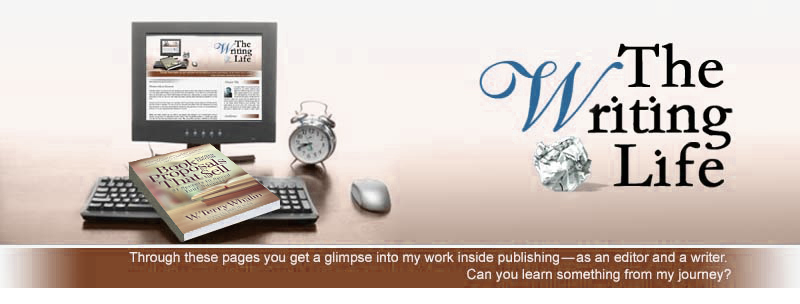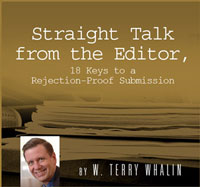By Terry Whalin @terrywhalin
As a writer, I participate in a
couple of online groups. Several of these groups, I have been an active
participant for decades. I hope you are active in some of these online
activities for your own growth as a writer and the opportunity serve and help
others. In one of these groups, members can ask questions and get help. Recently
an author asked about what to do with a submission to an agent. This author
followed the agent's submission guidelines and sent his material. The guidelines
gave an estimated time for a response but this writer hadn't received a response
and the time had been about three times past the estimated timeframe. What
should he do?
I understand this situation from
two perspectives. First, as a writer, I know the pain and frustration of waiting
with no response or even finally getting a form rejection letter. Many
publishers and agents never even bother to respond to the submission because of
the large volume they receive.
As an editor, I know the
challenges of responding to authors and while I try to be prompt and in touch,
I'm imperfect and know I have a number of submissions that I still need to press
forward for my publisher. The work is never done and there is always more to do,
another book manuscript and another author to process. Each of us have the same
time limitations and over the years I've tried to give myself (and others) some
measure of grace in how we communicate.
Each publisher, editor and literary
agent has their own system and method of responding and keeping up with their
authors and relationships. The easiest answer for an editor or agent to give is
one the author doesn't want to hear: “no thank you” or “not the right fit” or
“going to pass.” That's why in the title of this article I include the adjective
“gentle.” You want to be careful how you reach out to this decisionmaker/
gatekeeper to foster and build your relationship with them. While they may
reject your current idea, they may be attracted to your next idea. There is
truth in the old saying, “Never Burn A Bridge.”
In the remainder of this article,
I want to give you three submission ideas for your writing:
1. Simultaneously
submit. You should not wait around for a single editor or agent to
respond to you because for reasons outside of your knowledge or control, they
may never respond or respond months down the road. Waiting is hard for everyone.
Your best action as a writer it so submit to multiple places at the same time.
The key if you use this strategy is to explicitly say so in your cover letter
and/or proposal. Then a second critical step is when you sell the project or
sign with a literary agent or something happens, you need to notify everyone
else who has not responded. This step keeps the lines of communication clear,
transparent and professional.
2. Keep track of the
timeframe. How long has your submission been out? After a few weeks, it
is often time to send a gentle follow-up—which I will explain in the next
point.
3. Use The Gentle
Follow-up. A gentle follow-up reaches out to ask if they received it.
Maybe it got lost or arrived when they were out of their office. Or any number
of other things could have happened to yur submission. It's a reasonable
question to ask if they received it. If they have acknowledged their receipt (as
we do at Morgan James), then follow-up asking if they need any additional
information. This request is not pushing but gentle and reasonable and simple to
answer.
The reality is weird things
happen in the publishing world. Many of those strange things are outside of your
personal control. For example, I've written about 2,000 reviews on a large
bookseller's website (not going to say the specific name). During an afternoon
last week, about 800 of my posted reviews disappeared. I have no recourse or
anyone to ask about the reason. My response is to keep pressing forward and
writing more reviews.
If you haven't read my 10 Publishing
Myths book, I encourage you to take advantage of my special offer, get this
book and read it. Of my goals with this book was to explain that much of the
publishing process is outside of our control as writers. I balance this fact
with a series of pro-active actions every author can take to get the word out on
their book which will translate into sales. As you read this book and apply it
to your life, you will be able to take advantage of my decades of experiences in
the publishing world.
As writers, we need to use the
gentle follow-up with our submissions. What experiences have you had in this
area? Let me know in the comments below.
Labels: 10 Publishing Myths, agent, communication, editor, follow-up, publishing, rejection, simultaneous submission, Terry Whalin, The Writing Life, Three Reasons to Use Gentle Follow-up























2 Comment:
Terry, I really appreciate what you had to say in this article and find it helpful on two fronts. One, my instincts to reach out to you after ten days to make sure you had received the manuscript and ask if there were steps I should take to follow-up were spot on. I love when I am affirmed in trusting my gut. Secondly, I am taking to heart your advice to not put all of my eggs in one basket by submitting to many publishers. I will order your book today! Thank you! Jody Kemple, Writer
Jody,
I'm glad you found this article helpful. Doing follow-up in the right way is an important skill for every writer.
Terry
Post a Comment
That's the writing life...
Back to the home page...